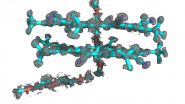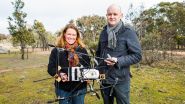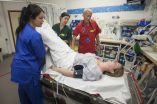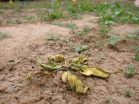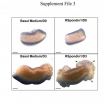(Press-News.org) A team from the University of Illinois at Urbana-Champaign and Indiana University combined two techniques to determine the structure of cyanostar, a new abiological molecule that captures unwanted negative ions in solutions.
When Semin Lee, a chemist and Beckman Institute postdoctoral fellow at Illinois, first created cyanostar at Indiana University, he knew the chemical properties, but couldn't determine the precise atomical structure. Lee synthesized cyanostar for its unique ability to bind with large, negatively charged ions, which could have applications such as removing perchlorate, a commercially produced contaminate that has been associated with negative effects on human health, from water and soil.
Determining the structure of a molecule, atom by atom, is important for both chemists and biologists to understand how molecules work and interact with surrounding material. In the past, each discipline had different ways to determine the structure based on the molecule's size and complexity.
To achieve the highest degree of accuracy, however, scientists have combined methods from both disciplines to determine the complicated structure of cyanostar, a symmetrical, five-sided macrocycle that is easy to synthesize and could also be useful in lithium ion batteries. These results are detailed in a paper recently published in the Journal of the American Chemical Society.
"There are two worlds which determine structure--the world of biology, which has big systems but often doesn't generate precise structural calculations," said Klaus Schulten, head of the Theoretical and Computational Biophysics Group (TCBG) at the Beckman Institute for Advanced Science and Technology at Illinois.
"Then there's the chemical world of smaller molecules, which results in super-precise calculations, but often can't account for disorder in the molecule."
Disorder--when a molecule has more than one way it can arrange itself--challenges traditional small molecule methodologies. Cyanostar, for example, can be arranged in four different ways.
To overcome the challenges of the disorder, Lee collaborated with Schulten's group, including Abhishek Singharoy, another Beckman Institute postdoctoral fellow who specializes in a computational simulation method called xMDFF (Molecular Dynamics Flexible Fitting). The method uses x-ray crystallography data to examine a molecule's structure.
"In x-ray crystallography, we don't look at single molecule," said Singharoy. "We look at a bunch packed into a single crystal, and shine an electron x-ray on it. This produces a diffraction of the crystal structure. It's still tricky to get a good image with a disordered molecule, so we had to use another program to refine the structure further."
The team combined xMDFF with PHENIX, a popular tool in the crystallography community developed by a group at the University of California, Berkeley.
"It's really an excellent combination of the two programs. We wouldn't have gotten the results we did without this computational partnership," Schulten said. "This entire project is really a wonderful example of how today's science is being done. The disciplines joined, the teams joined, and the computational programs joined. When you are open-minded and look to see what others can do, you are really better off."
The team, with the help of Chris Mayne, a research programmer in TCBG, also created specialized force fields, a set of rules that helps the computer program govern the connections between the molecules.
"The connections in biological (large) molecules are well studied because they are so common--they're lipids, nucleic acids, and proteins," said Mayne. "But cyanostar is an abiological molecule, so it's not constructed from the same set of biological building blocks. It required a customized force field, so we had to start from scratch."
With these newly developed force fields, the researchers could not only solve the structure of cyanostar, but it will allow the researchers to examine many more disordered abiological molecules.
"It opens an entire avenue. We can use these sorts of techniques to obtain the structures of multiple classes of abiological molecules," said Singharoy. "So that's where we'd like to go moving forward--use it as a general tool to start these other molecules."
INFORMATION:
Many political leaders, scientists, educators and parents believe that failure is the best teacher.
Scientists have long understood that the brain has two ways of learning. One is avoidance learning, which is a punishing, negative experience that trains the brain to avoid repeating mistakes. The other is reward-based learning, a positive, reinforcing experience in which the brain feels rewarded for reaching the right answer.
A new MRI study by USC and a group of international researchers has found that having the opportunity to learn from failure can turn it into ...
Since the early days of fertility treatment, women undergoing IVF treatment have had to place a hormonal gel in their vagina on a daily basis for at least 14 days after embryo transfer. The hormone is necessary to increase the chances of pregnancy, but it may also cause some side effects in the form of irritation and leaky discharge.
However, the results of a new scientific study suggest that women will be able to avoid this kind of discomfort in the future.
"Fertility treatment is a physical and mental challenge for childless couples. The daily treatment with hormonal ...
Researchers at The Australian National University (ANU) and The University of Sydney have developed a world-first radio-tracking drone to locate radio-tagged wildlife.
Lead researcher Dr Debbie Saunders from the ANU Fenner School of Environment and Society said the drones have successfully detected tiny radio transmitters weighing as little as one gram. The system has been tested by tracking bettongs at the Mulligan's Flat woodland sanctuary in Canberra.
"The small aerial robot will allow researchers to more rapidly and accurately find tagged wildlife, gain insights into ...
A research team at Linköping University, together with colleagues in Europe and the United States, has shown that at extremely high pressure even the innermost electrons in the atomic nuclei of the metal osmium begin to interact with each other, a phenomenon never witnessed before. The findings have been published in Nature.
"If we know more about how a matter works, we will be in a better position to develop materials that withstand extreme conditions. In research we're constantly making advances, but in this case we've taken a giant leap", says Igor Abrikosov, ...
A new £6.65 million grant for research aimed at accelerating the discovery and application of new advanced materials for the energy sector was announced today by the Engineering and Physical Sciences Research Council (EPSRC).
The grant, awarded to a team led by Professor Matthew Rosseinsky of the University of Liverpool, will support a programme, Integration of Computation and Experiment for Accelerated Materials Discovery.
Professor Rosseinsky will head up an expert team at Liverpool and University College London that will work to tackle the challenge of designing ...
Noroviruses are the predominant cause of gastroenteritis outbreaks in community settings such as hospitals, cruise ships, and schools. The virus is extremely contagious and is mostly transmitted via "fecal-oral-route", i.e., through contaminated hands or contaminated food. Symptoms include violent and sudden onset of diarrhea, vomiting, and nausea.
"It is therefore important to provide a safe and harmless disinfectant against human norovirus," explains Grant Hansman, head of CHS junior research group at the German Cancer Research Center noroviruses and the University ...
A simple, safe and cost-free modification to a physical technique used to treat patients in the emergency department with an abnormally fast heart rhythm could improve its effectiveness by more than a quarter, according to a study published in The Lancet today (25 August 2015).
An abnormally fast heart rhythm, also called supraventricular tachycardia, can be distressing for patients and many come to emergency departments for treatment. Symptoms can include chest pain, light-headedness, dizziness and breathlessness. Episodes can last from a few seconds or, in extreme cases, ...
This news release is available in German. Trillions of bacteria populate the human gut - which makes them more common than any other cells in our body. The composition of this bacterial population is very variable and influenced by our diet. Diseases, but also antibiotic treatments can induce significant shifts in this equilibrium. If entire bacterial groups suddenly multiply heavily, critical situations occur. They damage the intestinal tissue and cause inflammations. How such shifts are triggered largely remained a mystery. Physiologists from the University of Zurich ...
This news release is available in German.
Root bacteria are known to form symbiotic relationships with plants by improving the plants' supply of nutrients. Yet as scientists at the Max Planck Institute for Chemical Ecology in Jena, Germany, found recently, the bacteria actually play a much more profound role. During field experiments in Utah, in the western USA, researchers discovered that the right mixture of soil microbiota directly influences the survival of Nicotiana attenuata, a species of wild tobacco. Plants that had been unable to establish a protective ...
University of Manchester scientists have bridged a gap between two separate pieces of small intestine kept alive outside the body, in an advance which could have implications for surgery in human adults and babies.
It is not currently possible to study the intestine in embryos when inside the body, which holds back advances in treatment for conditions causing damage in infants. However, new techniques used by the researchers in this study have allowed organs to be kept alive and grown on supports which allow the absorption of nutrients.
A video is available here
or ...
